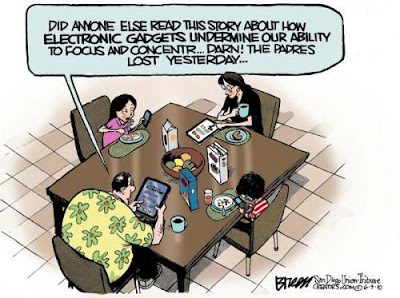Digital learning environments are demanding:
• material and digital content infrastructures need to be in place
• teachers know to use these purposefully
Find our reports on ICT in education informative? Then find the most relevant list in the second part of this post. These reports concentrate on opportunities in the use of ICT to improve education. Experiences with digital teaching technologies in rich countries are taken at heart when looking for realistic ways to foster progress in developing economies.• teachers know to use these purposefully
One thing becomes clear - indisputable. There is a link missing for in the classroom:
an intermediate step using lo-tech ICT.
So, first let us introduce the Nationwide Visualisation Project in all its simplicity and beauty. It is the most innovative ICT technology currently available: this is achievable now. It can be safely implemented nationwide on highschools in a sustainable manner. Within five months. It is time-proven and it delivers reliably, even in harsh conditions (click 'Testimonials' above).
Visualisation and interactivity are the key modernisations here. It provides excellent working conditions for teachers in 'chalk and talk' situations to prepare themselves and their students for digital teaching strategies.
This approach needs a one-off investment and only electricity is required.
Teachers in developing economies need robust and reliable tools in their classrooms. The
Nationwide Visualisation Project introduces simple to use teaching aids for highschools.
One of the 2500 visuals: "Put on - take off"
Just ask: "What tries this visual to explain?"
Just ask: "What tries this visual to explain?"
"Erosion and sedimentation"

The modernisation: from 'chalk and talk' (repetitive learning) to visualisation
and interactivity for efficiency in learning and to train thinking skills.
This system is effective. It gives full control to teachers used to 'chalk and talk'.
Teachers will train themselves each lesson in visualisation, to set clear goals
and to involve pupils: basic teaching skills to work with digital tools - when ready.
The Nationwide Visualisation Project introduces on highschools simple to use teaching aids
for five key-subjects: Geography, History, Physics, Chemistry and Biology
learning through thinking - strong visual clues as memory anchors
better results guaranteed
A systematic innovation - seven viewpoints: from modernisation of teaching, implementation, institutionalisation and training of teachers to cost-efficiency and more
 On each high school in 15 classrooms: powerful teaching tools for each lesson
On each high school in 15 classrooms: powerful teaching tools for each lesson Visualisation and interactivity in the classroom are the key-modernisations here.
Top pedagogy for efficiency in education now and for capacity building of teachers.
Allow your highschool teachers to work with up-to-date resources.
All it needs is electricity and a one-off investment at low cost.
For more on the Nationwide Visualisation Project, click here
************
but ........
But why not computer projectors and using the internet?
Look at the future!
Look at the future!
On ICT in education:
recent news from near and far - below, in six selected and updated reports
recent news from near and far - below, in six selected and updated reports
Summary Over-viewing the big picture makes clear that at this stage in emerging economies the first priority should be investing in computer labs in schools (for computer-literacy and as digital libraries) and systematically preparing the infrastructure needed for digital education.
In the mean time, UNESCO and other ICT-promoting donor agencies - very cleverly - invest in testing and customizing new promising yet unproven technologies in a few (small) countries as testing grounds. Until this new technology is made sustainable, really improves learning and is marketed at affordable prices, developing economies are paying over the odds. Experience in rich countries teaches that improving standards using ICT will take a while.
As an intermediate step for the classroom is lo-tech ICT - already achievable through school radio, TV and the most practical teachers' assistant, the overhead projector.
In the mean time, UNESCO and other ICT-promoting donor agencies - very cleverly - invest in testing and customizing new promising yet unproven technologies in a few (small) countries as testing grounds. Until this new technology is made sustainable, really improves learning and is marketed at affordable prices, developing economies are paying over the odds. Experience in rich countries teaches that improving standards using ICT will take a while.
As an intermediate step for the classroom is lo-tech ICT - already achievable through school radio, TV and the most practical teachers' assistant, the overhead projector.
This summary sounds logical?
What about the vision and today's reality in a typical low-income country:
 Telling news from Nigeria, as numbers of pupils grow and quality of education declines: 'Lagos State Trains Teachers on Cost-Effective Teaching Aids'
Telling news from Nigeria, as numbers of pupils grow and quality of education declines: 'Lagos State Trains Teachers on Cost-Effective Teaching Aids' Quote: "Some teachers in Junior Secondary Schools (JSS) drawn from three education districts in Lagos State were recently empowered to produce and use cost-effective instructional materials to stimulate teaching and learning among their students. The participants demonstrated their skills with the use of cardboard and paper to produce learning aids, depending on their subjects of specialization with enthusiasm at the five-day training programme ...
Aina, who has been teaching since 1987, added that the training would, aside from minimising the stress of teachers, also help students to learn more. "Though I have been using some of these methods before as a Visual Arts teacher, I have learnt new ones."
In 'This Day - Education' Sept 1, 2010.
Imagine the real progress with five days of training in using transparencies and a sturdy overhead-projector instead of paper and cardboard - see the Nationwide Visualisation Project.
FRIDAY, 28 MAY 2010 Nigeria
1 E-learning is not the point here!
For decades in Nigeria the numbers of pupils are increasing but the quality of education is deteriorating because of lack of money for the most elementary things. Last May the government decided to base education on digital ICT to turn the tide. But locals are convinced this policy is unrealistic. Reasons from the front line - why education in most African countries is not ready for the digital revolution. Read more
Five more reports with news to consider:
THURSDAY, 26 AUGUST 2010 - as in Australia
2 Why to save $46 billion (US$41 billion) on ICT
An update with recent publications on experiences in rich countries. Billions of dollars are spent every year without good success. As digital learning environments tend to lower learning results nationwide, governments now concentrate on better teachers. Digital pedagogy needs a leap forward first before it will live up to expectations. With conclusions for lower income countries. Read more
WEDNESDAY, 14 JULY 2010
3 Worlds of opportunities to improve education - a leap in digital pedagogy
Overview of purchasing power in high, middle and low-income countries and their investments in computer-based education. Also in Hong Kong it is concluded that a leap forward is needed in digital pedagogy to make their US$ 8 billion investment productive. On what innovations should each of the groups of countries concentrate now to prepare for their (digital) future? Read more
THURSDAY, 17 JUNE 2010
4 How to save US$120,000,000 on ICT - costs of digital learning
 In the UK large savings are made by dismantling BECTA, the organisation to implement digital teaching throughout the educational system. It sheds a light on the high demands and complexity of digital learning and the huge costs involved. How can lower income countries prepare for digital teaching? Read more
In the UK large savings are made by dismantling BECTA, the organisation to implement digital teaching throughout the educational system. It sheds a light on the high demands and complexity of digital learning and the huge costs involved. How can lower income countries prepare for digital teaching? Read moreMONDAY, 7 JUNE 2010
5 Evidence Please! - digital learning in poor countries
A short yet powerful statement about the failure of "one-laptop-per-child" projects. It is remarkable that Wayan Vota, for 5 years one of the strongest OLPC promoters, now launches a new but similar vision: "One powerful smartphone per teacher, or a combination of voice/SMS phones and smartphones for teachers and students, have the potential to actually achieve the unfulfilled technology saturation promise of One Laptop Per Child" (Edutech-debate Sept. 14, 2010).
For the reader to judge the realism.
There is a growing popularity in the ICT community for "leap-frog models" into the future with unproven ICT solutions for poor countries. As if the future is now. Step by step approaches which can help out today, get abandoned. Read more
SATURDAY, 29 MAY 2010
6 Avoid only "worst practice ICT use in education"?
The internet debate in April/May 2010 organised by InfoDev/World Bank: "Most Investments in Educational Technology are Wasted". In-depth on the wastes resulting from efforts to introduce computer-based learning in poor countries. Money is not used to prepare the infrastructure and other pre-conditions for digital teaching. Hopeful technologies are tried and again untested. What is the role of the advisors? What should be improved to get more digital value for money? Read more
Other articles in our archive bring forward the hopes and challenges for digital teaching and the urge for realistic policies to modernise education for all involved.
............................
In the mean time:
How to explain the flow of lowland rivers?
Here one of the 2500 visuals: "Put on - take off"
Just ask: "What changes the flow?"
Just ask: "What changes the flow?"
This system gives full control to teachers used to 'chalk and talk'.
Teachers will train themselves each lesson in visualisation, to set clear goals
and to involve pupils: basic teaching skills to work with digital tools - when ready.
All it needs is electricity and a one-off investment at low cost.
For more about the Nationwide Visualisation Project, click here

































